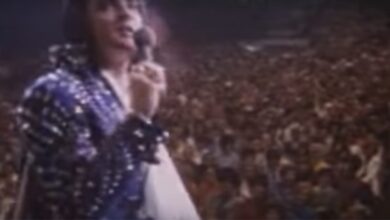The Emotional Duet “Don’t Cry Daddy” By Elvis And Lisa Marie Presley Might Bring Tears To Your Eyes
“Don’t Cry Daddy” stands as a significant piece in the legacy of Elvis Presley. Its narrative, grounded in the themes of grief and comfort, poignantly illustrates the complexities of family dynamics in the face of loss. The song has resonated with audiences not only for its lyrical depth but also for the heartfelt interpretation by Presley, who had a long-standing career of blending various musical styles. The elegant fusion of country elements in this ballad showcases Presley’s ability to transcend genre boundaries and reach into the emotional core of his listeners.
The songwriting, credited to Mac Davis, is layered with meaning. It tells the story of a father attempting to provide solace to his bereaved children, who are struggling with the absence of their mother. The simplicity yet profoundness of the lyrics emphasizes the need for parental strength in times of sorrow. This portrayal is particularly poignant as it reflects a universal experience—dealing with loss while striving to maintain family unity. Elvis’s interpretation enhances this narrative, as his rich vocal timbre and delivery evoke a sense of vulnerability and empathy.
Elvis Presley rose to fame in the 1950s, a time when music was undergoing a seismic shift towards more authentic forms of expression. His beginnings are deeply rooted in rock and roll, but he was never confined to a single style; he embraced diverse musical genres including blues, gospel, and country, which enabled him to connect with a broad audience. He often infused his performances with emotional nuance, allowing him to convey the underlying themes of the songs he chose. “Don’t Cry Daddy” is no exception, showcasing his artistry and emotional depth.
The release of the duet with Lisa Marie Presley in 1997 marked a profound moment in music history, as it blended two generations of talent. Lisa Marie, born into the legendary lineage of her father, developed her artistic voice and pursued a solo career in music. Her involvement in “Don’t Cry Daddy” added a remarkable layer of sentiment, delivering a heartfelt homage to her father’s legacy. This pairing not only solidified their familial bond but also bridged the past with the present, creating a celebration of their shared musical heritage.
In the realm of technological advancement, the collaboration between Elvis and Lisa Marie is a striking example of how modern methods can revitalize and honor historical art. The digital layering process used for the duet showcased an impressive amalgamation of innovation and respect for the original work. Engineers meticulously aligned Lisa Marie’s voice with her father’s, capturing the essence of his performance while respecting the emotional intensity embedded in the song. This project demonstrates how technology can act as a conduit for artistic expression, preserving the past while allowing for contemporary interpretation.
The emotional accessibility of “Don’t Cry Daddy” is what continues to resonate with audiences. People often find solace in music during times of grief, and this song’s themes allow listeners to reflect on their own experiences with loss and healing. This universal relatability is what cements the song’s place in the hearts of many. Fans of Elvis and those discovering the song for the first time can connect with the raw emotion conveyed, making it a timeless piece.
Moreover, the duet has had a lasting impact on the musical landscape, illustrating how familial legacies can continue to inspire future generations. Lisa Marie’s engagement with her father’s work encourages discussions around heritage, identity, and the importance of preserving family history through art. Her contributions to music reflect a desire to both honor her father’s legacy while carving her unique path within the industry.
As the years go by, songs like “Don’t Cry Daddy” endure as reminders of the powerful role music plays in our lives. They not only serve as a form of entertainment but also provide a vehicle for emotional expression. The profound relationship captured in the lyrics speaks to the societal need for connection and understanding, especially during difficult times. The combination of Elvis’s original artistry and Lisa Marie’s heartfelt tribute encapsulates the beauty of music as a healing tool.
In summary, the story behind “Don’t Cry Daddy” and its subsequent duet with Lisa Marie offers an intricate tapestry of emotion, legacy, and technological innovation. It underscores the significance of family ties in the fabric of music and life, demonstrating how artists can transcend generations. In this way, the collaboration serves as a powerful reminder of the enduring impact of Elvis Presley and the lasting resonance of his music, while also showcasing the transformative capabilities of modern technology in the arts.





